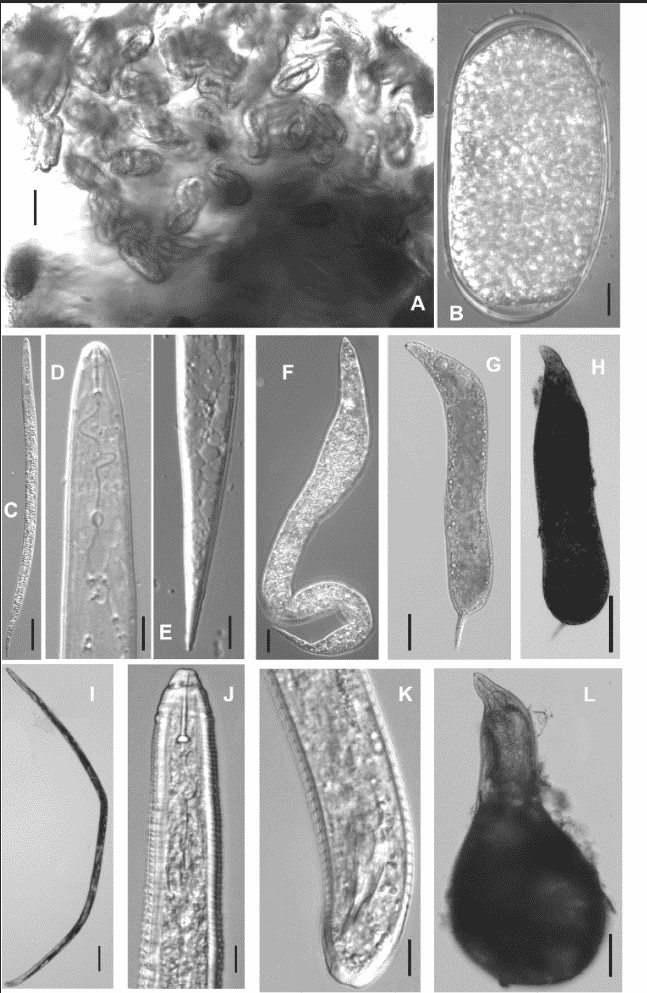Scientific classification
Kingdom:Animalia
Phylum:Nematoda
Class:Secernentea
Order:Tylenchida
Family:Heteroderidae
Genus:Meloidogyne
Species:M. incognita
Binomial name:Meloidogyne incognita

Introduction
Meloidogyne incognita (root-knot nematode - RKN), also known as the 'southern root-nematode' or 'cotton root-knot nematode' is a plant-parasitic roundworm in the family Heteroderidae. This nematode is one of the four commonest species worldwide and has numerous hosts. It typically incites large, usually irregular galls on roots as a result of parasitism. M. incognita can move along shallower temperature gradients (0.001C/cm) than any other known organism, an example of thermotaxis. The response is complicated and thought to allow the nematodes to move toward an appropriate level in soil, while they search for chemical cues that can guide them to specific roots.
Distribution
Meloidogyne incognita is widely spread around the globe and found in many different soil types.
Host
Meloidogyne incognita is probably the most economically important plant-parasitic nematode species among the tropical and subtropical regions. This nematode is extremely polyphagous, attacking both monocotyledons and dicotyledons. It is estimated that more than 3,000 plant species can be affected.
Symptoms
Plants affected by M. incognita presents above ground symptoms of water and nutrient stress, yellowing, wilting, and stunting. Below ground galling on roots, bulbs, tubers is the typical symptom. Plant death may occur in high infestation level.
Morphology
Females of M. incognita are pear-shaped with no posterior protuberance. Their stylet ranges from 15-16 µm long, and knobs are rounded and offset. Perineal pattern is oval to rounded, typically with high dorsal arch, striae usually wavy, and lateral field absent or weakly demarcated. Males have a not offset head with an elevated labial disc without lateral lips (usually). Their stylet ranges from 23-26 µm long, and knobs are rounded to oval and offset. Juveniles second stage body size range from 350-450 µm long. Their tail has rounded tip and range from 43-65 µm in length with 6-14 µm long hyaline region.
Life Cycle
Within the egg, the first molt occurs and a juvenile first state (J1) becomes a juvenile second stage (J2). Under favorable conditions (temperature, moisture, host stimulus) the J2 hatches, reaches and penetrates the host root. Root tips are the primary infection court. Once inside the roots, J2 migrate through cortical tissues towards the vascular zone where they establish a permanent feeding site called giant cell. At this point the nematode enlarges acquire a “sausage” shape and becomes sedentary. Three more molts occur, J2 becomes J3, J4 and then adult. M. incognita is sexually dimorphic. Females acquire a globose shaped body while males become vermiform and leave the roots. Upon maturity females lay eggs into a gelatinous mass that protect them against unfavorable environmental conditions, and the life cycle is repeated. It takes 37 days at 21 degree Celsius for M. incognita to complete its life cycle.
Management
Management of M. incognita depends primarily on the crop being affected and relies on multiple strategies such as cultural, biological and chemical control. Among the cultural control crop rotation with nonhost or resistant varieties can be used to keep the nematode population at tolerable levels. Also, usage of organic amendments and antagonistic crops such as Crotalaria spectabilis is effective against this nematode. Some fungus that parasites eggs, for example Paecilomyces lilacinus, have been using as a biological control. There are several nematicides out in the market for controlling M. incognita.
